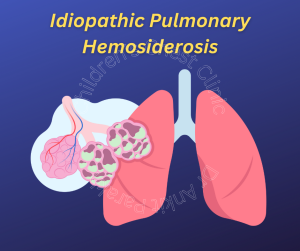Idiopathic pulmonary hemosiderosis (IPH) is a rare disease seen in children and adults. In patients with idiopathic pulmonary hemosiderosis (IPH) there are repeated episodes of bleeding into the alveolar sacs of the lungs. Repeated episodes of bleeding into the lungs leads to thickening of alveolar basement membranes, interstitial fibrosis and chronic lung damage.
What are the symptoms of pulmonary hemosiderosis in children?
Children with pulmonary hemosiderosis can present with very variable symptoms. Most children with pulmonary hemosiderosis present with coughing with blood or hemoptysis, shortness of breath or dyspnea and anemia due to bleeding in the lungs and iron deficiency. Not all children will have all the manifestations at one point of time. Many children present with acute symptoms with shortness of breath, hemoptysis, difficulty in breathing, anemia and respiratory failure. This corresponds to acute intra-alveolar bleeding. Some children present with slow onset dyspnea, chronic cough, anemia and presence of clubbing. This happens when there is slow bleeding into the alveoli of the lungs. Some children can have anemia as the only manifestation of pulmonary hemosiderosis.
What are the conditions which can lead to pulmonary hemosiderosis in children?
There are many conditions which can lead to recurrent pulmonary bleeding and pulmonary hemosiderosis in children. These conditions are Goodpasture syndrome, Wegener’s granulomatosis, pauci-immune complex vasculitis, celiac disease, Henoch-Schoenlein purpura, pulmonary capillaritis and systemic lupus erythematosus. In children where no cause is found the diagnosis of idiopathic pulmonary hemosiderosis (IPH) is considered. Idiopathic pulmonary hemosiderosis (IPH) is a diagnosis which is made after excluding the secondary causes of pulmonary bleeding.

How is pulmonary hemosiderosis diagnosed in children?
Investigations are targeted towards diagnosing pulmonary bleeding, localizing the site of pulmonary bleeding (alveoli in case of pulmonary hemosiderosis) and to find the cause of pulmonary hemosiderosis. Chest Xrays during acute episodes show diffuse shadows on both sides of the lungs. Gradually the infiltrates tend to get better and in chronic stage interstitial, reticular and micronodular patterns of opacities are seen. Computed tomography (CT) scans Chest with angiography shows ground-glass attenuation and are useful in looking at other causes of bleeding. Bronchoscopy is perhaps the most useful investigation to evaluate the airway in detail for bleeding. A bronchoalveolar lavage (BAL) sample is also taken. BAL will demonstrate alveolar macrophages filled with hemosiderin (iron) which is diagnostic of pulmonary hemosiderosis. Blood counts, tissue transglutaminase antibody, anti-glomerular basement membrane antibodies (Anti-GBM), anti-neutrophil cytoplasmic antibodies (ANCA), antinuclear (ANA) and anti-DNA (ds-DNA) antibodies are done to evaluate for the causes of pulmonary hemosiderosis.
How is pulmonary hemosiderosis treated in children?
The mainstay of treatment of idiopathic pulmonary hemosiderosis in children are steroids and other immunosuppressive agents. Steroids are usually used in the form of a high dose pulse given for 3 days and repeated monthly for 6-12 months. Immunosuppressive agents are usually required in addition for steroid sparing effect. Most commonly used are hydroxychloroquine and azathioprine. In refractory cases cyclophosphamide and rituximab are used. The overall duration of treatment varies from 3-5 years.
In case your child has a pulmonary bleeding or has been diagnosed with idiopathic pulmonary hemosiderosis you need to get in touch with a pediatric pulmonologist for a proper diagnosis and treatment.






